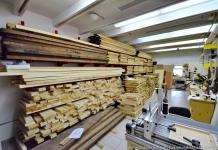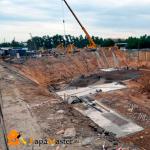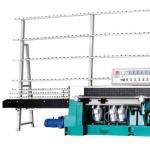received
fee 50%
Hello Eugene. It is impossible to build an apartment building, no matter for what purpose, on a land plot intended for individual housing construction.
You can only build an individual residential building, and it can also have isolated living quarters that can be rented out.
The construction of an apartment building involves changing the purpose of the land plot - for the construction of an apartment building. Which is most likely impossible.
Hello.
If the administration establishes the fact that the house is an apartment building, for example, based on a complaint from neighbors, then it may well go to court with a lawsuit to demolish the house, because. it will be a standalone building.
Decree of the Federal Antimonopoly Service of the North Caucasus District dated March 26, 2012 in case N A32-19509 / 2011
In refusing to satisfy the application, the court rejected the plaintiff's claims to recognize the ownership of the apartment building erected by the plaintiff. According to the court, in accordance with the provisions of Art. 51 of the Town Planning Code of the Russian Federation, Art. 3 of the Federal Law “On Architectural Activities in the Russian Federation”, construction, reconstruction of capital construction projects, as well as their overhaul are carried out on the basis of a construction permit, which is issued by the local government at the location of the land plot where construction is planned. At the same time, according to paragraph 26 of the Decree of the Plenum of the Supreme Arbitration Court of the Russian Federation and the Plenum of the Supreme Arbitration Court of the Russian Federation dated April 29, 2010 N 10/22, the absence of a building permit in itself cannot serve as a basis for refusing a claim for recognition of ownership of an unauthorized construction, it is necessary to establish whether whether the person who created the unauthorized structure, appropriate measures to legalize it, in particular, to obtain a building permit and / or an act of putting the facility into operation. As established by the court, the plaintiff has permission to build a three-story individual residential building. However, in fact, the plaintiff erected a five-story multi-apartment residential building, which does not correspond to the permit documentation. Evidence of a change in the type of permitted use of the land plot, compliance with the established procedure for obtaining a permit for the construction of a five-story apartment building, the availability of design documentation for the erected facility, as well as appeals to the authorized bodies to agree on the construction of the disputed facility are absent in the case file. Thus, there are no grounds for satisfying the plaintiff's claims.
KOSTROMA REGIONAL COURT
APPEALS DETERMINATION
dated December 5, 2014 in case No. 33-1885
By order of the Department of Property and Land Relations of the Kostroma Region dated DD.MM.YYYY N, the above land plot with a total area of 748 sq. m located at:<адрес>, courtesy of H.A.I. free of charge to the property as the owner of the real estate object, with the permitted use "for the operation of an individual residential building." Ownership of the land has passed the state registration, which is confirmed by a certificate from DD.MM.YYYY.
Filing claims for the demolition of the object at the address:<адрес>, the plaintiff pointed out that the object has signs of an unauthorized structure, since it is an apartment building, it was erected without a building permit, in violation of the intended purpose of the land plot, technical norms and rules were violated during its construction, in connection with which the structure threatens life and health citizens.
The defendant's position was that the house is an individual, three-story house built for the residence of one family, and therefore it was not required to obtain permission to build a house, to produce and approve project documentation. The construction of the facility has not been completed, all identified violations are correctable and will be eliminated during construction.
Assessing and examining the evidence presented in accordance with Article. 67 of the Civil Procedure Code of the Russian Federation, the court of first instance came to the conclusion that the disputed object has the features of an apartment building. The defendant produced new construction, before it began the development of project documentation in accordance with Art. 48 of the Civil Code of the Russian Federation, which is subject to examination, was not carried out, a building permit was not obtained, in the process of issuing which the types of permitted construction and its limiting parameters are determined, compliance with urban planning regulations in accordance with Art. 51 GRK RF. Taking into account the established circumstances, the court of first instance concluded that the disputed object has all the signs of unauthorized construction: an apartment building was erected on a land plot not allocated for these purposes in the manner prescribed by law, without obtaining the necessary permits, with a significant violation of urban planning and building codes and rules, incl. partially located outside the boundaries of the land plot, violates the rights and legitimate interests of third parties, creates a threat to the life and health of citizens. Under the above circumstances, an immovable property located at:<адрес>, to be demolished.
Thus, the disputed object is an unauthorized construction, which was erected in violation of building codes and regulations on a land plot not allocated for the construction of an apartment building, partially on a land plot not owned by the defendants, and creates a threat to people's life and health.
The consequences of unauthorized construction are established by Art. 222 of the Civil Code of the Russian Federation. A person who has carried out unauthorized construction shall not acquire the right of ownership to it. It has no right to dispose of the building - to sell, donate, lease, make other transactions. Unauthorized construction is subject to demolition by the person who carried it out or at his expense, except for the cases provided for by paragraph 3 of this article. The right of ownership to an unauthorized construction may be recognized by a court, and in cases provided for by law in another procedure established by law, the person in whose ownership, lifetime inheritable possession, permanent (unlimited) use is the land plot where the construction was carried out. In this case, the person who has recognized the right of ownership of the building shall reimburse the person who carried it out for the costs of the building in the amount determined by the court. The right of ownership to an unauthorized structure cannot be recognized for the said person if the preservation of the structure violates the rights and legally protected interests of other persons or poses a threat to the life and health of citizens.
In accordance with the legal position of the Constitutional Court of the Russian Federation, set out in the Ruling of July 3, 2007 N 595-O-P, unauthorized construction is an offense that consists in violating the norms of land legislation governing the provision of a land plot for construction, urban planning regulations governing design and construction. According to the literal meaning of paragraph 1 of Art. 222 of the Civil Code of the Russian Federation, the sanction contained in it can be applied if the guilt of a citizen in the implementation of unauthorized construction is proved. The implementation of unauthorized construction is a guilty act, the proof of which is the establishment of at least one of the three conditions listed in paragraph 1 of Article 222 of the Civil Code of the Russian Federation.
Taking into account, as well as the provisions of par. 2 p. 2 art. 222 of the Civil Code of the Russian Federation, paragraph 3 of Art. 76 of the Land Code of the Russian Federation, the obligation to demolish an unauthorized building should be assigned to the person who carried out the unauthorized construction, that is, to the owner Kh.A.I.
In accordance with the clarifications contained in paragraph 23 of the Resolution of the Plenum of the Supreme Court of the Russian Federation N 10 and the Plenum of the Supreme Arbitration Court of the Russian Federation N 22 dated April 29, 2010 “On some issues arising in judicial practice in resolving disputes related to the protection of property rights and other rights in rem”, the court’s decision to satisfy the claim for the demolition of the unauthorized building serves as the basis for making an entry in the USRR on the termination of the defendant’s ownership of the unauthorized building.
In view of the foregoing, this decision is the basis for the termination in the Unified State Register of Rights to Real Estate and transactions with it of the record of ownership of Kh.A.I. and V. to the object of individual housing construction - a 3-storey residential building with a total area<данные изъяты>sq. m inventory number N letter B at:<адрес>.
In order to build an apartment building, you need to change the type of permitted use of the land plot, if the land plot belongs to the lands of settlements.
URBAN PLANNING CODE OF THE RUSSIAN FEDERATION
Article 37. Types of Permitted Use of Land Plots and Capital Construction Objects
1. Permitted use of land plots and capital construction facilities may be of the following types:
1) the main types of permitted use;
2) conditionally permitted uses;
3) ancillary types of permitted use, admissible only as additional in relation to the main types of permitted use and conditionally permitted types of use and carried out together with them.
2. With regard to each territorial zone, the types of permitted use of land plots and capital construction facilities are established.
3. Change of one type of permitted use of land plots and capital construction facilities to another type of such use is carried out in accordance with the urban planning regulations, subject to compliance with the requirements of technical regulations.
4. The main and auxiliary types of permitted use of land plots and capital construction objects by the right holders of land plots and capital construction objects, with the exception of state authorities, local governments, state and municipal institutions, state and municipal unitary enterprises, are chosen independently without additional permits and approval .
5. Decisions to change one type of permitted use of land plots and capital construction facilities located on lands to which town planning regulations do not apply or for which town planning regulations are not established, to another type of such use are made in accordance with federal laws.
Hello Eugene.
You will definitely have problems:
1. You may be denied registration of ownership of a property
2. Your apartment building may be classified as unauthorized construction and demolished.
Numerous judicial practice confirms what has been said, including in Moscow and the Moscow region!
"Overview of the practice of resolving disputes by courts arising in connection with the participation of citizens in the shared construction of apartment buildings and other real estate objects" (approved by the Presidium of the Supreme Court of the Russian Federation on 04.12.2013)
M.A.N. on a land plot of 600 sq. m, intended for individual housing construction, on the basis of building permits, a residential building with a total area of 1005.9 sq. m. The bodies that carry out state registration of rights to real estate and transactions with it registered the ownership of M.A.N. to this house. On the basis of a contract for the sale of real estate objects, the owners of a residential building located on the specified land plot on the basis of the right of common shared ownership are, in addition to M.A.N., also B.K.V., G.O.A., G.V. A., O.M.L., R.L.N. and others (total 14 people).
By the decision of the Lyubertsy City Court of the Moscow Region the claims of the prosecutor of the city of Lyubertsy, Moscow Region, in the interests of T.Yu.A., the municipality Malakhovka Urban Settlement, Lyubertsy Municipal District, Moscow Region, against M. for the demolition of an unauthorized building were satisfied. changes.
Determination of the Judicial Collegium for Administrative Cases of the Moscow Regional Court, which considered the appeals of B.K.V., G.O.A., G.V.A., O.M.L., R.L.N., court decisions were canceled, the claims of the prosecutor of the city of Lyubertsy, Moscow Region, were satisfied.
As can be seen from the case materials (inspection report, technical documentation, etc.), a three-story residential building (two ground floors and an attic floor) was erected on the indicated land plot. On each of the floors there are actually 8 or 9 separate apartments, all of them are numbered, have a separate exit to the corridor, a separate bathroom, a separate kitchen equipped with a stove. From the residential building there is one exit on the ground floor to the land plot adjacent to the house.
The residential building erected by the defendant is, in fact, intended and actually used for the residence of several families who are not related to the developer and live in separate isolated premises.
Taking into account the content of paragraphs 5 and 6 of the Regulations on the recognition of premises as residential premises, residential premises unfit for habitation and an apartment building as emergency and subject to demolition or reconstruction (approved by Decree of the Government of the Russian Federation of January 28, 2006 N 47), which defines the signs of a residential building, apartment, apartment building, the panel of judges considered that the totality of the evidence presented in the case file reliably confirms the fact of the construction of M.A.N. an apartment building on a land plot intended for the construction of an individual housing construction facility, in violation of the requirements of civil law regarding the intended use of land. The defendant did not receive a permit for the construction of an apartment building, and did not apply for commissioning in the prescribed manner.
Thus, based on the provisions of articles 222 (paragraph 1) and 263 (paragraph 1) of the Civil Code of the Russian Federation, as well as articles 7 (paragraph 2) and 40 (subparagraph 2 of paragraph 1) of the Civil Code of the Russian Federation, articles 1, 2, 8, 9, 30 , 36, 44, 47, 48, 55 GrK RF erected by M.A.N. the residential building was recognized by the Judicial Board for Administrative Cases of the Moscow Regional Court as an unauthorized construction.
According to paragraph 2 of Article 222 of the Civil Code of the Russian Federation, paragraphs 23 and 24 of the resolution of the Plenum of the Supreme Court of the Russian Federation and the Plenum of the Supreme Arbitration Court of the Russian Federation dated April 29, 2010 N 10/22 “On some issues arising in judicial practice in resolving disputes related to the protection property rights and other property rights" on M.A.N. ordered to carry out the demolition of the building.
For example, the Judicial Collegium for Civil Cases of the Moscow Regional Court by the Appeal ruling dated April 2, 2014 in case N 33-3589/2014 installed:
the administration of the urban settlement of the Odintsovo municipal district of the Moscow region filed a lawsuit against the defendants for the demolition of an unauthorized building - an apartment building. The claim is motivated by the fact that the disputed apartment building was erected without a building permit, on a land plot intended for individual residential construction, in a low-rise building zone, without the possibility of connecting to the central water supply and sewerage systems, in gross violation of urban planning legislation, as well as norms and rules for the construction technology of facilities (Urban Planning Code of the Russian Federation, SNiP 2.08.01-89, SP 30-102-99, SNiP 2.07.01-89, SNiP 31-02-2001, etc.).
Representatives of the defendants objected to the satisfaction of the claim, pointing out that the master plan of the urban settlement, as well as the building plan, were not approved, the defendants are inadequate - so, in accordance with Art. 222 of the Civil Code of the Russian Federation, claims for the demolition of an unauthorized building are presented not to the owner, but to the developer. For some owners, this residential building is the only place of residence in the Russian Federation, people purchased apartments for personal residence, two families actually live in the house. The administration interferes in changing the purpose of the land plot. The house stands 20 meters from the administration, was built in front of the administration, and since 2008 it has not raised the issue of the illegality of its construction or its demolition, the plaintiff has not proven that unauthorized construction poses a threat to the life and health of citizens, in itself, the lack of permission to construction does not serve as a basis for the demolition of an existing facility, the rights to which are registered in the manner prescribed by law. The residential building was erected in the residential area in accordance with the Development Rules of the city of Odintsovo, approved by Decree N 931 of 03.10.2012.
The representative of a third party - the Department of Architecture and Urban Planning of the Administration of the Odintsovo Municipal District of the Moscow Region - supported the administration's claim, saying that the land plot was intended for individual housing construction.
Considering the type of permitted use of the land plot, it is permissible to build on it a single-family residential building with no more than three floors, intended for the residence of one family (SP 55.13330.2011, paragraph 3 of article 48 of the Civil Code of the Russian Federation, paragraph 1 of article 49 of the Civil Code of the Russian Federation ).
Representatives of the Department of Architecture and Urban Planning of the Administration of the Odintsovo Municipal District carried out inspection visits, as a result of which it was established that a 4-storey apartment building was erected on the land plot.
The rightholders of the land plot did not apply to the Department of Urban Planning Architecture, i.е. did not take appropriate actions aimed at legalizing unauthorized construction and compliance with urban planning legislation.
Considering that the disputed object is actually an apartment building, in accordance with the provisions of Art. 48, 49, 52, 54, 55 of the Civil Code of the Russian Federation, the construction of such facilities must be carried out by specialized organizations that have a SRO certificate, on the basis of design documentation that has passed an examination, under the supervision of Gosstroynadzor (authorized body).
As follows from the response of the Glavgosstroynadzor of the Moscow Region dated February 18, 2013 N Zh-59/31 and the Order of the Glavgosstroynadzor of the Moscow Region N 44i dated November 16, 2011, the developer did not apply to the state construction supervision authorities with a notice of the start of construction of the facility, state construction supervision over the construction of the facility was not carried out on the specified land plot. According to the results of linear measurements, violations of fire-prevention distances between the disputed building and residential buildings located in neighboring areas were established. The objects are not connected to the central water supply and sewerage networks. Since the quality of construction and installation work in the house does not meet the requirements of the regulatory and technical documents for residential buildings, there are doubts about the durability and maintainability of the house (violations of SP 54.13330.2011 (SNiP 31-01-2003) "Residential multi-apartment buildings").
The defendants believe that this lawsuit violates their constitutional rights as owners of the land plot, and the plaintiff did not prove the violation of his rights and freedoms by the construction of the structure, the limitation period established by Art. 199 of the Civil Code of the Russian Federation, in connection with which they asked to dismiss the claim.
It follows from the case file that the defendants are the share owners of a land plot for individual housing construction.
According to the project, the house should be heated by gas boilers from the existing gas pipeline, water supply should be carried out from the existing well, sewerage - individual local treatment facilities, in the future, connection to sewer networks, waste disposal - into metal containers through the conclusion of a garbage disposal agreement. This project was developed in accordance with sanitary and epidemiological standards. After acquiring apartments in a multi-apartment residential building, the defendants took measures to legalize the residential building and bring it to a state suitable for habitation - providing the house with engineering communications.
Regarding the defendants' statement that the administration missed the limitation period, it should be noted that the requirement to demolish an unauthorized structure that poses a threat to the life and health of citizens is not subject to limitation.
According to the explanations given in paragraph 2 of clause 24 of the Resolution of the Plenum of the Supreme Court of the Russian Federation and the Plenum of the Supreme Arbitration Court of the Russian Federation dated April 29, 2010 N 10/22 “On some issues arising in judicial practice in resolving disputes related to the protection of property rights and other rights in rem”, the defendant in a claim for the demolition of an unauthorized building is the person who carried out the unauthorized construction. If an unauthorized building is in the possession of a person who did not carry out unauthorized construction, the defendant in a claim for the demolition of the unauthorized building is the person who would have become the owner if the building had not been unauthorized.
After examining all the circumstances of the case, the panel of judges came to the conclusion that there were grounds to satisfy the stated claim for the demolition of an unauthorized building, since during the consideration of the case it was established that an unauthorized apartment building was erected on a land plot for individual residential construction.
A monolithic multi-storey building is a serious object in which the heating, water supply, ventilation, power supply and sewerage systems are connected into a single whole.
The construction process is divided into several stages, which ultimately affects the time. Despite this, multi-storey buildings are increasingly being built using monolithic technology.
The main stages of the construction of multi-storey buildings using monolithic technology
Any construction of a multi-storey building using monolithic technology is a lengthy and painstaking procedure. Moreover, this applies not only to the construction work itself, but also to the approval of the project and other paper documentation.
Consider the main stages of the construction of a monolithic high-rise building:
- 1. Perhaps the most difficult stage is connected just not with construction. To get started, you need obtain a building permit and select a suitable site. Then comes a difficult period of coordinating controversial issues with the local administration (given the complexity of the urban construction sector, this stage will take a huge amount of time and nerves).
- 2. On the allocated plot of land geological and topological exploration . It is necessary to correctly determine the type of soil and its composition, the depth of groundwater, the level of soil freezing and other important indicators.
 Pit for the construction of a residential building
Pit for the construction of a residential building  Pile field under a monolithic house
Pile field under a monolithic house  Removable formwork
Removable formwork  Removable wall formwork
Removable wall formwork
- 3. The most important step is development of a multi-storey building project . It includes all the necessary construction documentation: material calculation, engineering systems, sections, floor plans, final estimate. The project is the last paper document and after it the stages of construction work begin.
- 4. The site is being laid out and preparatory work is underway to prepare the foundation. Necessary dig a pit and drive piles under the foundation. After that, the installation of the frame from the reinforcement begins (use a rod of rectangular or round section). During the construction of a multi-storey building using monolithic technology, the frame plays an important role - it gives the structure the necessary rigidity.
- 5. Performed installation of removable formwork from wooden shields, polystyrene foam or plastic. You can use ready-made formwork. At the end of assembly, produce pouring concrete mortar with further tamping (use deep vibrators). Now it remains to wait for the complete drying and hardening of the mixture, after which the formwork is dismantled. Various additives can be used to speed up the process. According to this principle, they build floor by floor.
- 6. Insulation and facade finishing produced after the complete drying of the last layer of concrete. It takes at least 28 days, and even more in wet and cold weather.
- 7. At the final stage, the house connected to all necessary communications . After that, the territory adjacent to the house is ennobled.
 Fixed formwork (example)
Fixed formwork (example)  Construction of a multi-storey building using monolithic technology
Construction of a multi-storey building using monolithic technology
Advantages of monolithic multi-storey buildings
Monolithic high-rise buildings have obvious advantages over brick and panel counterparts.
- First of all, it is worth highlighting their reliability and compactness.
- An important component is external attractiveness.
- An insulated and plastered monolithic high-rise building looks much better than a panel or brick one.
- In addition, very often, when building a multi-storey building using monolithic technology, additional architectural techniques and elements are used: ledges, bay windows, curved walls, window openings with original geometry.
- One of the key benefits is durability. Thanks to a special construction technology, the monolithic structure has fewer joints, which can significantly increase the service life. Such buildings can be built in seismically active areas.
- Monolithic high-rise buildings are ideal as objects with a developed infrastructure. In the basement and first floors there is the possibility of arranging retail outlets, sports facilities, parking lots and other establishments.
Disadvantages of monolithic skyscrapers
The disadvantages include reasons that are not related to the operational characteristics of buildings. The main negative point is the likelihood of shifting the deadlines for the completion of the object. This happens due to an incorrect calculation or when the weather conditions worsen. This includes the complexity of the work, because not every company can master a monolithic structure.
Issue price
It may seem that, taking into account the above characteristics, the cost of such a house is several times higher than the budget of similar buildings made of panels and bricks. In fact, their cost is approximately equal, and with a well-designed project, it can be even lower. An analysis of the real estate market shows that housing prices in monolithic high-rise buildings are 10-15% lower. Thus, this property can be considered an excellent investment.
How to build a monolithic house April 25th, 2016
The construction of residential buildings is one of the important branches of construction. Housing is being built always and everywhere - it is simply impossible to do without it. Housing construction can be different: it is high-rise or low-rise construction, brick or monolithic, etc. Today I want to show several main stages of building a monolithic multi-storey building. For better clarity, photos of the construction of different houses will be used.
The first stage of building a house itself is earthworks. Those. First, they dig a foundation pit for the foundation of the future building. After the foundation pit is ready, the pile field is driven. Piles are not always driven, but in our city this is done quite often. Whether piles are needed or not depends on the geological conditions of the site chosen for construction.
The photo on the left just shows a section of the pile field. On the right, the equipment for the first stage of construction work is located - an excavator for excavating a pit and a piling machine. 
Here is another piling machine. Such machines are different - which one to work depends on the type of piling work carried out and on the type of piles used. As a rule, in our city either driven piles or bored (bored injection) piles are used. Driven piles are usually reinforced concrete rods. To immerse them in the ground, only special devices are required. Therefore, in individual construction, they are used quite rarely. The high cost of the piles themselves, as well as the rental of equipment, leave their mark.
Most often, bored piles are used. First, a hole is made in the soil with a special drill, into which a reinforced frame is then inserted by a machine. Then the well is filled with concrete solution, which fills all the voids. 
Here, the process of preparing a well for a future bored pile is shown. 
Pile field closer. Bored piles are visible here. 
General form 
Then the foundation is made. This is the basis of any building, a guarantee that the structure will stand for many years without deformation. The main function of the foundation is to carry the mass of the building, and the key requirement for it is strength. The foundations are also different, for example, monolithic (slab) and prefabricated. In multi-storey construction, a slab foundation is used. Such a foundation is resistant to any kind of deformation and copes very well with vertical maximum loads without significant loss of its functional qualities. Since this is a monolithic foundation, its main element is cast reinforced concrete. It withstands loads and shifts of the soil well. A reinforcement frame is installed in the dug pit, which is then poured with concrete. Moreover, the filling is continuous. The photo shows an already poured monolithic foundation. 
Bigger. In winter, after pouring, the concrete is covered with a special material. This is done to warm up the concrete, which helps to maintain the strength of the concrete. 
Well, then comes the construction of the floors of the future house. Since our house is monolithic, the main tasks in such construction are the preparation of a reinforced frame and the subsequent pouring of the frame with concrete. 
Reinforcement sticking out of concrete is the future basis of the frame of future walls. 
When the frame is ready, it is enclosed in the formwork. The formwork creates the shape and dimensions of the future wall, column and ceiling. After the formwork is assembled and the process of pouring concrete takes place. The pouring takes place with the help of concrete pumps. While the number of storeys of the building is not high, concrete pumps are used.
The photo shows a concrete pump truck - this is a white machine with an elongated blue arrow. Concrete is directed along this arrow. 
By the way, before assembling the reinforced frame or pouring it with concrete, the territory is cleaned from dust and various elements (stones, sand, etc.). This is done with special air vacuum cleaners, and it looks like the photo below. 
A larger concrete pump truck - at the moment when a mixer with concrete drove up to it. 
This is how the walls of the building are poured 
And here, in fact, is the process of assembling a reinforced frame. The reinforcement in the frame is directed both vertically and horizontally. 
Openings in the frame are made immediately. 
Concrete is delivered to the upper floors by a special pump or by a crane, using a "bell" for this. 
This is how concrete is poured with a crane and a "bell" - one presses the levers, the other directs the flow. 
The crane is also used to lift other building materials to the floors - formwork, reinforcement, beams. 
For the construction of a floor slab (this is the future floor or ceiling of an apartment), a reinforced frame is also needed. 
But first, the formwork is installed (pictured), and then a reinforcement frame is assembled on the formwork, which is also poured with concrete. 
But builders need to know exactly where the floor boundaries will go, where holes, walls, columns and other elements will be located. To do this, a surveyor is needed at the construction site, who, using various instruments (as in the photo), will make an accurate breakdown of the location of the above elements. 
The basis of the building is a monolithic frame. But various partitions and balconies are made of brick (pictured) or building blocks. And here you can’t do without masons, who perform these works. 
Balconies are made of bricks, facade walls and partitions are made of blocks. 
This is just part of building a house. Here you can not do without finishing work - both external (facade arrangement) and internal. But I'll tell you about this another time.
The implementation of any housing project begins with the purchase by the developer of land from a private owner. Or the right to lease urban land is acquired at auction. Usually, the winner of the auction of the Property Fund must complete the design of the object within 11 months from the date of signing the protocol on the results of the auction. Construction takes from three to five years, depending on investment conditions. If the land is owned by the developer, he can start building the facility after he receives all the necessary approvals and building permits.
From design to resolution
The procedure for preparing the documentation required to start construction is the same for developers who have purchased land at the auction of the Property Fund, and for those who have bought land from a private owner. The difference is only in the number of approvals that need to be passed. According to Taras Kruchinin, General Director of ISK Sphere, the purchase of a plot at the auction of the Property Fund can significantly reduce the time to obtain the documents necessary for building a house. “The city is selling plots with a full package of approvals, as well as technical conditions for connecting the future building to engineering networks,” Kruchinin says.
To obtain a building permit, it is necessary to conduct surveys on the site and achieve approval of the project in state bodies. As Vitaly Kolot, project manager at O2 Development, explained, at this stage the developer also receives technical conditions for connecting the future home to engineering networks and an urban development plan. In addition, it is necessary to develop a building project, which must be agreed upon in the relevant committees and regulatory authorities. The list of all departments in which you need to get "go-ahead" depends on the complexity of the project, location, etc.
After approvals in the city committees, the project is sent for examination: in St. Petersburg, it is carried out by the State Expertise Center subordinate to the State Construction Supervision and Expertise Service (Gosstroynadzor) or licensed private structures. The average term for the examination is 40 calendar days.
According to statistics, only 70% of initially submitted projects receive positive conclusions - the rest are returned to developers for revision.
Having a positive expert opinion in hand, the developer applies to Gosstroynadzor to obtain permission to build an apartment building.
By law, Gosstroynadzor must issue a building permit within ten days from the date of application. In the event that the developer has submitted an incomplete set of documents or has drawn them up incorrectly, the service issues a conclusion on the refusal.
Construction process
Note that before obtaining a building permit, any work on the construction of a house is prohibited. In practice, it turns out differently: almost a quarter of all violations detected by the State Construction Supervision Authority are the construction of facilities without a permit.
After obtaining permits, the process of building a house starts. First comes the so-called zero stage, at which the preparation of the base of the foundation takes place. After that, contractors begin construction and installation work - they erect walls and ceilings, install windows and doors, and connect the house to utilities. “The penultimate stage is the interior and exterior decoration of the facility, after which the developer carries out work on the improvement of the adjacent territory,” says Vitaliy Kolot.
According to Lev Gnidenko, General Director of Oykumena, building a house is the most understandable stage in the implementation of any project. “It is much more difficult to obtain the necessary approvals from government agencies, pass an examination of the project and agree on the allocation of the necessary capacities with monopolists,” he says.
The final stage of the project implementation is obtaining permission to commission a residential building (in St. Petersburg they are issued by the State Construction Supervision Authority, in the Leningrad Region - by the municipal authorities). At this stage, the supervisory authorities determine the compliance of the erected house with the requirements of technical regulations, SNIPs, and the initially approved project. The developer is also required to provide confirmation that he has complied with the technical conditions for connecting the building to engineering networks. If the constructed object meets all these conditions, the building supervision authority is obliged to issue a permit to put the object into operation - according to the law, this must be done within ten days from the date of submission of the relevant application.
The commissioning permit is the basis for putting the constructed object on state registration. After that, the developer formalizes the ownership of the apartments - first for himself, and then for the buyers who entered into equity agreements with him.
When is the best time to buy
In accordance with 214-FZ, the developer has the right to sell apartments from the moment they receive a building permit. But in a number of cases, companies try to sell housing immediately after they have acquired a plot for the construction of a house - citizens are offered to buy an apartment 5-15% cheaper than after the start of "official sales". Potential buyers can sign a preliminary contract of sale or an agreement on the preliminary booking of an apartment.
As Oleg Ostrovsky, head of the Department for Control and Supervision in the Field of Shared Construction of the St. Petersburg Construction Committee, warns, the sale of housing by a developer before obtaining a building permit is a direct violation of 214-FZ. The fact is that contracts signed during this period cannot be registered with the Rosreestr department. This means that the risks of citizens increase significantly: theoretically, your apartment can be sold twice.
It makes sense to conclude an equity participation agreement immediately after the developer has received a building permit and opened sales: at this stage, you can purchase the most liquid objects. Inexpensive apartments with good characteristics are often “taken apart” a few months after the start of sales - but by the end of construction, only “kopeck pieces” and “three rubles” of large areas remain in the house. But by purchasing an apartment at the stage of excavation, you run the risk of waiting for a housewarming party for several years - construction is sometimes delayed for an indefinite period.
By the time the work is completed and the house is put into operation, the apartments in it are about 30% more expensive than at the initial stage of construction. At the commissioning stage, there are quite a few proposals from private investors who have purchased apartments in this building at the foundation pit stage and resell them by the time the work is completed - under cession agreements.
Citizens who buy housing at the final stages of construction (from a developer or a private investor) bear much lower risks than those who purchase apartments at the stage of excavation. However, the process of putting the house into operation can drag on for several months, during which you will have to wait for a housewarming party.
Of course, it is safest to buy an apartment in a house that has already been rented and is ready for occupancy: but this is the most expensive option. According to statistics, the cost of such housing is on average 7-10% more expensive than in neighboring houses put into operation several years ago.
In the matter of acquiring housing under construction, it is better to be guided by the rule of the golden mean: it is wiser to buy an apartment at a time when the house has been built by about 30-50% (a year and a half after the start of construction). In this case, you will be able to independently assess the progress of construction work, the prospects for completing the object, choose the apartment you like and buy it cheaper than in a practically finished object.
It makes sense to pay attention to apartments in houses that are planned to be completed no later than in the next year and a half. You won’t lose much money: now one-room apartments in houses with a due date in 2016 are only 200-300 thousand rubles cheaper than in those that are planned to be commissioned before the end of 2014. The choice is yours.
Text: Sergey Bardin Photo: Alexey Alexandronok
The construction of a multi-storey residential building today is the main solution to the housing problem for many developers. The advantage of the technology is the settlement of not one, but several families in the house, even if the construction is carried out on a small plot of land. Several types of construction are popular: panel, brick, monolithic, monolithic-brick. The choice of the type of development is carried out in accordance with the indications of soils, seismological conditions, climatic features, availability of materials, means and capabilities. Building land with multi-storey buildings is a responsible job that does not allow ignorance or blunders and requires strict adherence to all the nuances.
Panel construction
The technology was rapidly developed at the end of the last century due to the efficiency of all stages of work. The presence of ready-made elements allows you to set up houses without any special delays, the process resembles the assembly of a designer, the elements are produced in a factory way.
The conditions for the use of panel construction have their own characteristics:
- The requirement to carry out mass development in a limited area;
- Sale of finished housing at a price that covers the cost of work;
- The presence of a powerful base of resources and equipment used.
Advice! The construction of a panel high-rise building is impossible without the use of lifting mechanisms and the provision of energy resources.
The scope of application of the technology extends not only to the construction of multi-storey buildings for public settlement, but also for private housing construction, where it is required to build a building of 2-4 floors. The technology involves the use of two types of residential buildings: frame, frameless.
Skeletons also have two building options: full frame or internal. The former are a spatial frame, in the formation of which supports of the external type and ribbed panels participate, and the frame is formed by transverse and longitudinal elements. The second option is a design without supporting column panels. The carriers are internal columns that take on the entire load. The optimal span in this case is 500-600 cm. The longitudinal part of the frame is represented by columns, the pitch of which is not more than 300 cm. The permissible floor height is 280 cm, the crossbar and column elements are combined and connected by means of welds. The column is covered with I-beam steel cantilevers. The height of frame structures is calculated depending on the purpose of the building.
Main stages of construction

Stages of panel construction:
- Foundation work. The choice of base depends on the number of storeys of the building, the type of soil and other nuances. When working with lightweight panels (SIP), lightweight foundations are preferable; when working with heavy reinforced concrete panels, a strong and deep foundation is chosen.
- Waterproofing of the foundation, treatment of wooden and metal parts with protective agents, installation of the lower beam.
- Arrangement of the basement, laying the floor of the first floor.
- Arrangement of the frame or installation of the first floor by erecting panel elements, fastening parts by welding.
- Installation of interfloor ceilings around the perimeter of the floor.
- Building insulation and waterproofing.

Important! The construction of all subsequent floors is carried out in the same way as the installation of the first. If it is assumed that there are rooms of a large area, the structure is reinforced with a high-strength beam.
- Roof laying. The work is carried out taking into account the weight load on the panel.
- Installation of windows, doors, roofing.
- Finishing work.
This technology has its advantages and disadvantages, the advantages of a panel multi-storey building are as follows:
- Increased building assembly speed;
- The possibility of reducing the size of the construction site due to the work "from the wheels", that is, the material is brought from the manufacturer and immediately mounted on the site, without cluttering the construction site;
- The minimum set of instruments and equipment for the installation of prefabricated structures.
Disadvantages of panel housing construction:
- Low thermal performance in comparison with other materials;
- Insufficient sound insulation;
- The slightest deviations in the technology of joining joints will lead to the formation of cracks;
- Reduced seismic resistance of panel-type high-rise buildings;
- The dependence of the layout on the manufactured panel elements (this applies only to large-panel houses).
Construction of brick houses

Brick construction technology became known a long time ago, even before our era, people built dwellings from burnt pieces of clay, giving them almost the correct size. The technology is simple, reliable, does not require special equipment, except for lifts, however, it is difficult to implement and rather laborious. At the same time, brick construction is impossible without the experience, knowledge and employment of highly skilled workers. Minimal masonry errors will lead to irreparable loss of appearance, so the brick construction of a multi-storey building should either be carried out under constant supervision, or only by the hands of professionals.
Today, 2 types of bricks are used:
- Ceramic piece product has strength, heat resistance, seismic resistance, moisture resistance. At the same time, the brick is easy to manufacture.
- Silicate is made from a mixture of lime and sand, has a cheaper price and its characteristics are more modest: it does not tolerate moisture, high-temperature conditions.
Advice! Manufacturers offer a good alternative: hollow (slotted, porous) brick. Due to the voids in the mass, the product has a greater heat capacity and provides better thermal insulation.

Stages of building a brick house:
- Foundation. A powerful, durable and well-buried foundation is required, as the brickwork is massive.
- Foundation waterproofing.
- The first row of masonry on a “dry” basis, then the next rows of masonry are performed, and the choice of the option for installing bricks is carried out depending on the features of the project, the height of the house and the preferences of the customer;
- Reinforcing masonry elements or "bundle" should be present in every 2-4 row;
- Laying of interfloor ceilings is carried out in a slab way;
- Each subsequent floor is laid out, like the first one, one should not forget about the bonding and strengthening of wall panels.
- Building insulation and waterproofing;
- The roof is mounted rough, mostly flat. Laying of the finishing roof is carried out only after shrinkage of the structure.
- Installation of windows, doors.
- Final finishing work.
The brick construction of a multi-storey building has a lot of nuances: from the choice of the type of masonry to the variability of the bundle. However, despite the difficulties, the numerous advantages of the end result redeem all technological inconveniences:
- The highest thermal performance;
- The best soundproof indicators;
- Preservation of a comfortable microclimate inside the house;
- Variability of building formats;
- Undemanding facade finishes due to the good aesthetic appearance of bare bricks.
There are several disadvantages:
- Mandatory use of skilled labor;
- High price level of construction works;
- Slow construction of the house;
- Shrinkage time requirement;
- Limited number of storeys of buildings;
- Mandatory presence of a large warehouse for material at the construction site.
Monolithic construction

One of the newest technologies is the monolithic construction of a residential building. The type of development is based on pouring the building with concrete mix directly on the construction site. The cost of work is high, labor costs are also high, therefore, monolithic-panel construction is most often used, where building is carried out using ready-made prefabricated reinforced concrete slabs. Considering the monolithic technology, it is worth clarifying that all processes are carried out only in seasons with warm temperatures; in case of precipitation, work stops. A detailed plan of the work being carried out is extremely necessary, since any deviation from the process, delay or wrong choice of cement brand threatens to violate the technology, as a result of which the developer will receive an unstable house that requires constant finishing touches.
Construction stages:
- Site preparation, arrangement of a deep foundation;
- Reinforcing cage installation;
- formwork installation;
- Pouring concrete mix;
- Warming up concrete for better setting in case of a decrease in ambient temperature;
- Formwork dismantling;
- Arrangement of interfloor ceilings;
- Roof installation;
- External finishing.

Important! Concrete compositions are distinguished by high rates of insulation, energy intensity, so the structure will not require additional work on laying hydro, heat, and sound insulation. There is no need to further align the wall panels, that is, all work is reduced to finishing.
Advantages of monolithic construction:
- Free layout;
- Individual configuration of buildings;
- The smoothness of all wall and ceiling panels, due to which the finishing stage is reduced to a minimum;
- Increased seismic resistance of buildings.
Disadvantages of monolithic construction:
- The use of highly skilled labor;
- The high cost of building construction;
- Little use of technology.
Important! It is worth noting that the technology of monolithic construction is of little demand in today's market, however, numerous advantages make it possible to use the type of housing construction on a wide variety of soils. And if you use a panel-monolithic version, the buildings meet the highest demands and requirements of the owners, differing in strength, practicality, long service life and excellent heat and power performance.
Monolithic-brick construction

Frame-monolithic building technology has become widespread. Being the most modern option, the type of building is reliable, it allows you to combine in one object all the indicators of a heat- and sound-proof brick wall with the variability of building planning solutions using monolithic reinforced concrete floors. The price bar of buildings lies between inexpensive large-panel technology and costly brick houses.
The construction stages are similar to other technologies:
- Arrangement of a powerful foundation;
- Installation of the frame of the house with concrete pouring, then the formwork is removed and the process is repeated until the building reaches the desired height;
- Installation of interfloor ceilings;
- Construction of the next floors;
- Arrangement of a draft type roof, and after shrinkage of the structure, installation of a finishing roof;
- Finishing work.
Advantages of monolithic-brick construction:
- The most modern technology that allows you to quickly build buildings of different heights, shapes, formats;
- Free layout;
- High rates of heat capacity and sound insulation: such a high-rise building combines all the unique qualities of brick and concrete;
- Minimum requirements for leveling walls and ceilings, which means lighter finishing work.
The disadvantage of a multi-apartment monolithic-brick house will have one - the obligatory observance of building technology, and, consequently, the use of highly skilled workers.
Monolithic ventilation facades

Strictly speaking, this is not a construction technology, but rather a type of finishing work. Systems are characterized by the following indicators:
- The presence of an air gap between the surface of the wall and the finish;
- Possibility of using various types of sheathing panels;
- Giving aesthetics to the facade and minimizing the threat of condensation in the house;
- Significant reduction in heating costs due to an increase in the heat capacity of the entire building.
This technology is used for many multi-storey buildings for various purposes. At the same time, the materials used for the installation of ventilation facades are produced in a huge variety: aluminum, vinyl panels or panel elements made of composite materials are durable and strong.
Choosing the appropriate technology for the construction of multi-storey buildings, it is necessary to take into account not only all economic aspects, but also the presence of a powerful base of special equipment, resources and professional builders. It is difficult to cope with a house even on 2-3 floors alone, it is better to entrust this matter to specialists.


















